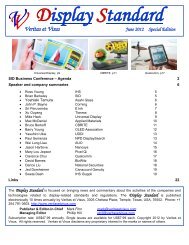Create successful ePaper yourself
Turn your PDF publications into a flip-book with our unique Google optimized e-Paper software.
<strong>Veritas</strong> <strong>et</strong> <strong>Visus</strong> <strong>Display</strong> <strong>Standard</strong> February 2009<br />
SID <strong>Display</strong> Week 2008 Symposium<br />
May 20-23, Los Angeles, California<br />
In this third report of three, Phillip Hill covers the pick of the poster sessions with presentations<br />
from Toshiba Matsushita <strong>Display</strong> Technology, National Chiao Tung University, KDDI R&D<br />
Laboratories Inc./Tokai University, Korea University/ i-components, Otsuka Electronics, Industrial<br />
Technology Research Institute/ISUZU Optics Corp., Tatung University/Chunghwa Picture Tubes,<br />
Eldim, and the Center for Devices and Radiological Health/FIMI/Philips<br />
Relationship of Moving Edge Color Distortion and Response Spectrum<br />
Yoshi Enami, Otsuka Electronics, Shiga, Japan<br />
Moving edge color distortion is a phenomenon that is often seen in PDP TVs and other displays that use a phosphor<br />
and in displays using field sequential drive. By observation using a moving picture evaluation system using a color<br />
pursuit camera, which the company has developed, the company was able to confirm that moving edge color<br />
distortion also occurs in LCDs. In order to clarify the cause of moving edge color distortion in an LCD, the<br />
response of the LCD was measured using a high-speed spectrom<strong>et</strong>er, and as a result, they were able to confirm that<br />
wavelength-dependence of r<strong>et</strong>ardation is a cause of moving edge color distortion.<br />
Pursuit images of respective types of displays taken by<br />
a moving picture evaluation system with a color pursuit<br />
camera (MPRT-2000CM) are shown in the photo.<br />
Images taken by this m<strong>et</strong>hod are considered to be close<br />
to those perceived by the tracking vision of a human.<br />
Next, by d<strong>et</strong>ermining cross sections in the moving<br />
picture movement direction of these images, the<br />
moving picture response curves in terms of the<br />
intensity measured by the CCD camera are obtained.<br />
By performing a matrix conversion, moving picture<br />
response curves of the R, G, and B pixels of a display<br />
can be d<strong>et</strong>ermined.<br />
Measurements of the spectral response by a high-speed spectrom<strong>et</strong>er showed that the wavelength dependence of the<br />
liquid crystal r<strong>et</strong>ardation is a cause of differences in the response speeds of the respective LCD display elements.<br />
Although the measurement m<strong>et</strong>hod requires improvement, response measurement using the high-speed<br />
spectrom<strong>et</strong>er enables simulation of the moving edge color distortion in the liquid crystal cell state, and the<br />
possibilities of simulation can be widened, for example, by adding information on the backlight, a simulation<br />
evaluation close to the final product state can be made. Presently, moving edge color distortion of LCDs is not<br />
discussed much. However it is considered that as further improvements are made in regard to moving edge blur, the<br />
influence of moving edge color distortion will become greater. In order to make improvements to moving edge<br />
color distortion, the respective display elements should be made uniform in response speed by making<br />
improvements to the wavelength dependence of the liquid crystal r<strong>et</strong>ardation, the company concludes.<br />
46<br />
Pursuit image of an LCD PC taken by the pursuit color<br />
camera system. The gray level is varied from black to<br />
white (0-255). The scrolling speed is 8 lines/frame and an<br />
XGA video signal is used.






